| Author |
Message |
Craig Peters

|
 Posted: Sun 27 Apr, 2014 6:27 am Post subject: 12th Century Daggers Posted: Sun 27 Apr, 2014 6:27 am Post subject: 12th Century Daggers |
 |
|
As many dagger enthusiasts well know, it is exceedingly difficult to find daggers or military knives which can be reliably dated prior to the 13th century, excluding the seax. I have posted, in another thread, about weapons which I think are daggers found in an early 11th century manuscript. Aside from this, Logan Thompson's book Daggers and Bayonets lists two daggers as being from the late 12th century onwards, although since we have so little evidence for daggers at this time, I would tend to think they are properly 13th century weapons, or perhaps 14th century. But aside from these two attributions, I was aware of no others.
While looking up more information on the subject, I was surprised to discover that Wikipedia mentions,"The earliest known depiction of a cross-hilt dagger is the so-called 'Guido Relief' inside the Grossmünster of Zürich (c. 1120)" (http://en.wikipedia.org/wiki/Dagger#Middle_Ages). Intrigued, I looked to see if I could find a photograph of this relief, and fortunately, the Bildarchiv foto Marburg has one. Those of you who have spent much time perusing David Nicolle's books might recognize this image, although for most everyone else, I imagine it will be new. Although I had seen it before, I believe that I had previously only seen a line drawing by Nicolle, and I had assumed the weapon was a sword. Contrary to what Wikipedia says, Foto Marburg dates the relief to circa 1160-1180 AD; however, this still places it well within the 12th century.
The question is, do you think the weapon shown is indeed a dagger, or is it really a sword? Given how clearly the disk pommels are represented on the other swords in the image, not to mention their crosses, it seems somewhat unlikely that it is a sword. Sadly, the image gives us little indication of the shape of the blade. If a dagger, is there a dark line in the blade because it has "three sharp edges" like the new weapons observed by William the Breton in his prose account of the Battle of Bouvines? (http://deremilitari.org/2014/03/the-battle-of-bouvines-1214/). Or should it be interpreted as a fuller?
One thing that seems reasonably certain is that the shape of the guard and the grip is rather like those of the misericords Tod has for sale. See the attached image from his webpage (http://www.todsstuff.co.uk/knives-military/mi...knives.htm) below. But should the grip be interpreted as wood? Or should it be interpreted some other way?
An equally pertinent question we might ask is, assuming that the weapon is not a sword, is it even a military knife? Or is it just a civilian tool being used in a military context?
Although this image raises more questions that it answers, it may nevertheless serve as an invaluable piece of period evidence for pre-13th century military knives.
 Attachment: 16.77 KB Attachment: 16.77 KB
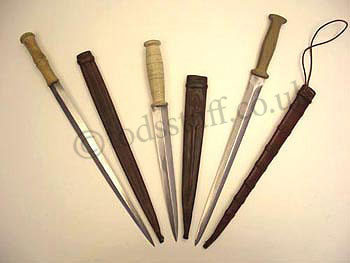
 Attachment: 174.17 KB Attachment: 174.17 KB
[ Download ]
|
|
  |
 |
Kai Lawson

|
 Posted: Sun 27 Apr, 2014 6:44 am Post subject: Posted: Sun 27 Apr, 2014 6:44 am Post subject: |
 |
|
I have no training or authority on this, but it immediately reminded my of a smaller eating knife/'day use' knife. It looks a bit like a small seax to me, and without a larger picture, detail is difficult to discern. The line could be a fuller, a third 'edge' or some sort of blade decoration (inlay, carving, etc…). However, I am very interested in this time period, and very much appreciate you posting the information and the image! The more people who can see the few images that are left, the better the items can be identified.
"And they crossed swords."
--William Goldman, alias S. Morgenstern
|
|
  |
 |
|
Tim Lison
|
 Posted: Sun 27 Apr, 2014 9:09 am Post subject: Posted: Sun 27 Apr, 2014 9:09 am Post subject: |
 |
|
|
It looks like a seax or at least single a edged knife to me too. The shape of the grip and the ridge along the top of the blade both scream seax to me. So many seaxes had fullers or ridges on that part of the blade, notice how offset the line is. That is NOT a central rib. The spine looks like it slopes too, which would also be common for a seax. I suppose it could be just a poor representation of a central rib or fuller, but I give the artist a little more credit. Medieval artists were not always the best at *rendering* what they saw but they were very clever about *indicating* what you were supposed to be seeing. Hard to say with any certainty though, I say interperate it how you want.
|
|
  |
 |
Leo Todeschini
Industry Professional

|
 Posted: Sun 27 Apr, 2014 1:18 pm Post subject: Posted: Sun 27 Apr, 2014 1:18 pm Post subject: |
 |
|
I am afraid that I can't locate the image you are referring to so can't comment on that.
This area is very tricky and has been touched on before on MA, but the bottom line is that information is very sketchy.
I recently was looking at this area for a project and came across this reference in Toby Capwells, knives daggers and bayonets. The text actually says 'after' and in this context I am not sure what this means as the drawings look original rather than a modern sketch of the manuscript. However what is illustrated are a few quillon daggers.
The preceding page is also very interesting in the context of your question.
All of this does however pose far more questions than answers.
Sorry for the bad pictures, but it should be clear enough I hope. Thanks Toby for another good reference book.
Tod
 Attachment: 88.67 KB Attachment: 88.67 KB
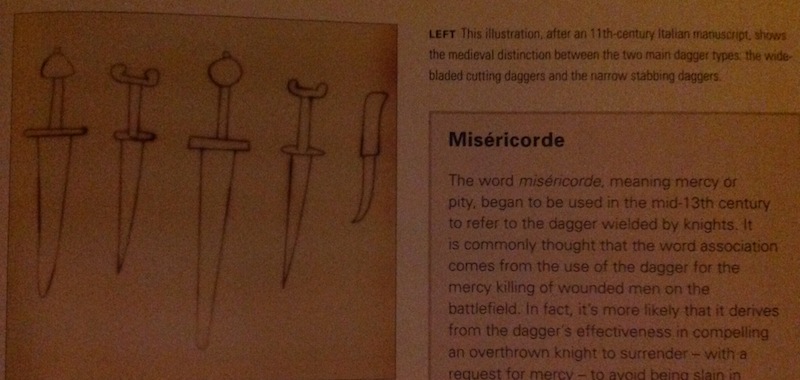
 Attachment: 182.42 KB Attachment: 182.42 KB

www.todsworkshop.com
www.todcutler.com
www.instagram.com/todsworkshop
https://www.facebook.com/TodsWorkshop
www.youtube.com/user/todsstuff1
|
|
   |
 |
Craig Peters

|
 Posted: Sun 27 Apr, 2014 5:14 pm Post subject: Posted: Sun 27 Apr, 2014 5:14 pm Post subject: |
 |
|
Tod,
I know the first image well; it's from the Hrabanus Maurus of Monte Cassino. I have a colour image of it in my thread on 11th century daggers.
I hesitate to term all of the weapons in the image daggers. It's not clear to me that the "quillon daggers" in the image are not actually swords drawn with a poor sense of scale. They could be quillon daggers, but without having a translation of the manuscript's text, which still may not tell us, it is difficult to be certain.
|
|
  |
 |
Leo Todeschini
Industry Professional

|
 Posted: Sun 27 Apr, 2014 11:53 pm Post subject: Posted: Sun 27 Apr, 2014 11:53 pm Post subject: |
 |
|
Craig just directed me to a good copy of the relief and can be found here. http://www.bildindex.de/dokumente/html/obj20769154#|home
My thoughts are…the spangenhelms with nasals look early to me, so my gut feeling is closer to the start of the 12thC. The ice pick grip and smaller scale of the weapon indicate that it is a dagger rather than a sword. Obviously much is lost in the difference between looking a photo like this and looking at the real relief, but I see no evidence this dagger represents a cross hilt dagger; I see no evidence or witness that it had a guard that has broken away and as it looks now I would not say this dagger has a guard.
It does look pretty much like a seax to me, but the inscribed line I think we cannot take much from either its presence or its location. Look at the sword just to the left and presumably this is a double edged blade, probably with a fuller and of lenticular section and yet it has a line/groove very close to one edge. Presumably this is used to provide definition and form rather than in this case to provide detail of the sword itself.
Craig Peters wrote | Quote: | Tod,
I know the first image well; it's from the Hrabanus Maurus of Monte Cassino. I have a colour image of it in my thread on 11th century daggers.
I hesitate to term all of the weapons in the image daggers. It's not clear to me that the "quillon daggers" in the image are not actually swords drawn with a poor sense of scale. They could be quillon daggers, but without having a translation of the manuscript's text, which still may not tell us, it is difficult to be certain.
|
Thanks - I didn't have a source for it.
Looking at that picture from left to right. 2nd and 4th are clearly single edged and may be swords, but I think far more likely to be daggers. 1st on left could be a badly rendered double edged blade, but I would lean toward single and so again I think dagger. Far right could be anything without a context, but is the same form as a sica and that was an established though earlier dagger form, so it does work as a dagger. The middle one I would say is far more open to contention; clearly double edged and longer. The form works for either sword or dagger and that may be the crux of your/our problem in that artwork will never completely answer the question of what these are.
I like most, can just add conjecture and gut feeling to the debate, nothing solid I am afraid, though my gut feeling is as follows. Daggers were known to be in use from year dot to the end of the seax age (circa 1100?) and again from say 1250 onward. So the gap from 1100 to 1250 will have something in it and of course the question is what. A time of transition is always a time of experimentation and so variety would have been the norm. So old die hards have seaxs, some guys have noted that penetration is better than cutting with the advent of more armour so some are single edged, some are double. Some guys like the balance of a pommeled dagger, other like the light weight of an unbalanced dagger. Some guys like a short handy 'brawling' blade others like the posturing of a long blade, some are richer, some are poorer. At some point a rough outline of the classic medieval cross form dagger was born and this proved to work well in all requirements and an approximate standard was set.
www.todsworkshop.com
www.todcutler.com
www.instagram.com/todsworkshop
https://www.facebook.com/TodsWorkshop
www.youtube.com/user/todsstuff1
|
|
   |
 |
Craig Peters

|
 Posted: Mon 28 Apr, 2014 8:39 am Post subject: Posted: Mon 28 Apr, 2014 8:39 am Post subject: |
 |
|
Initially, I resisted the idea of the image depicted a seax, because I thought that 1160-1180 AD would be too late. While it could be true that the relief is incorrectly dated by the Foto Marburg, it's not impossible that the weapons depicted really are seaxes at such a "late" date. Re-browsing the images from Manuscript Miniatures, I came across the following image from the Liber ad Honorem Augusti, which dates to around 1194-1196. While I would like to be able to find evidence of some form of daggers, I am hard pressed to state that the weapons shown here are anything other than seaxes. Further, the figures who wield them seem like they might not even be knights.
The situation is somewhat frustrating to me; on the one hand, there seems to be reasonably clear evidence of daggers looking at numbers 2 and 4 from Hrabanus Maurus, regardless of whether the other weapons shown are daggers or not. On the other hand, it seems like the only 12th century images I've been able to locate thus far invariably show some form of seax. Are there quillon daggers or any other form of dagger at all in the 12th century? If not, have we misinterpreted the evidence from Hrabanus Maurus?
 Attachment: 113.43 KB Attachment: 113.43 KB
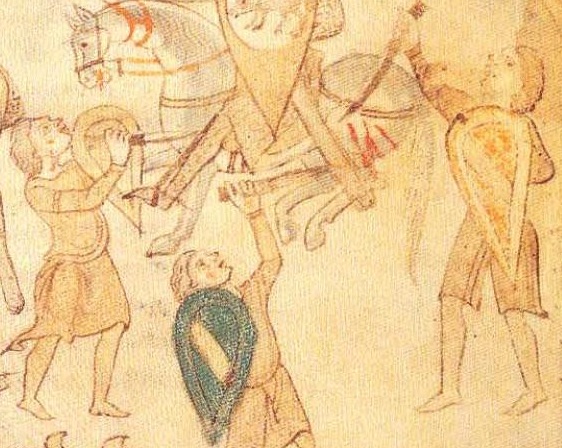
|
|
  |
 |
|
Mart Shearer
|
 Posted: Mon 28 Apr, 2014 3:29 pm Post subject: Posted: Mon 28 Apr, 2014 3:29 pm Post subject: |
 |
|
A more direct link to the Bildindex image.

The 13th century Battle of Bouvines Latin description concerning the long, slender, three-bladed knives is unique.
| Quote: | | Pugnatur ergo ibi ab utraque parte admirabili virtute et cadunt multi ibique ante oculos ipsius Regis occiditur Stephanus de Longo-campo miles probus et tídei integra cultello recepto in capite per ocularium galeae Hostes enim quodam genere armorum utebantur admirabili et hactenùs inaudito habebant enim cultellos longos graciles trialamines quolibet acumine indifferenter à cúspide usque ad manubrium quibiis utebantur pro gladiis |
Some manuscript copies have trialamines, three leaves or three blades, as tricumines, three cumins (cumin seed being longitudinally ridged). Perhaps a triangular blade with fullers?
If I remember correctly, the early 13th century Phillipde account of Bouvines also mentions daggers which are sharpened only in a third of the blade. That doesn't help much for the 12th century, but may offer an alternate explanation of the three bladed dagger mentioned.
ferrum ferro acuitur et homo exacuit faciem amici sui
|
|
  |
 |
Leo Todeschini
Industry Professional

|
 Posted: Mon 28 Apr, 2014 9:55 pm Post subject: Posted: Mon 28 Apr, 2014 9:55 pm Post subject: |
 |
|
Craig Peters wrote | Quote: | While it could be true that the relief is incorrectly dated by the Foto Marburg, it's not impossible that the weapons depicted really are seaxes at such a "late" date. Re-browsing the images from Manuscript Miniatures, I came across the following image from the Liber ad Honorem Augusti, which dates to around 1194-1196. While I would like to be able to find evidence of some form of daggers, I am hard pressed to state that the weapons shown here are anything other than seaxes. Further, the figures who wield them seem like they might not even be knights.
|
I share your frustration with this. I would also agree that those daggers shown are seax in form at a much later date than I would have supposed was current for them. However I do wonder about their context in the picture. The three man attacking the knight are unarmoured, un shod and clearly poor. They are also using round topped kite shields which I believe are also pretty unfashionable by this time, so could this be part of the language of the picture that they are poor men with outmoded kit?
What is also interesting (side issue-sorry) with this now is that if seax were current in circa 1180, what were the scabbards like?
Tod
www.todsworkshop.com
www.todcutler.com
www.instagram.com/todsworkshop
https://www.facebook.com/TodsWorkshop
www.youtube.com/user/todsstuff1
|
|
   |
 |
|
James Rayner
|
 Posted: Sun 17 Feb, 2019 5:40 am Post subject: Posted: Sun 17 Feb, 2019 5:40 am Post subject: |
 |
|
I've been meaning to contribute this for some years.
Attached is a photo of a dagger in Moyes Hall Museum In Bury St Edmunds, Suffolk.
It's in a 1903 museum catalogue as being found at the site of the battle of Fornham just 3 miles from the museum.
That battle occurred in October 1173.
If the find record is correct and I've no reason to doubt it, the site has produced a couple of swords, spears and arrowheads over the years, then we are possibly looking at an actual 12th century dagger.
The river Lark (which was quite a busy trade route in the past) passes by the the site, so it's not inconceivable that it could have been lost in later centuries but i'm not expert on dagger forms through the ages, so whether it matches known known types of any date i'll leave for you all to decide.
It's approximately 300mm long and 30mm at the widest part of the blade. Diamond blade profile with two narrow fullers running from the grip for about a quarter of the blades length.
Hope this is of use, interest to some.
 Attachment: 74.26 KB Attachment: 74.26 KB
[ Download ]
|
|
  |
 |
|
Mart Shearer
|
 Posted: Sun 17 Feb, 2019 1:13 pm Post subject: Posted: Sun 17 Feb, 2019 1:13 pm Post subject: |
 |
|
Clearly, that's a 14th century baselard.
ferrum ferro acuitur et homo exacuit faciem amici sui
|
|
  |
 |
Leo Todeschini
Industry Professional

|
|
   |
 |
Craig Peters

|
 Posted: Sun 17 Feb, 2019 7:26 pm Post subject: Posted: Sun 17 Feb, 2019 7:26 pm Post subject: |
 |
|
Hi James,
I want to approach this dagger slightly differently from how Mart and Tod responded, looking at limitations of this approach to dating the dagger.
When weapons or other artifacts are found and alleged to be from the site of a battle, we need to be cautious in assuming that this definitively provides a date. One thing I would ask is whether this dagger was found at precisely the location of the battle, or nearby. While “nearby” might sound like almost the same thing, it’s not, and there’s much greater possibility if the artifact is nearby that is does not date to the time of the battle. Secondly, the other swords and artifacts need to be considered: can they be given a fairly confident date of belonging to the 12th century based upon form and style? Or was the attribution of date made because of proximity to the battle site? Was the dagger found side by side with the other weapons, or could it belong to a different strata of the soil, and perhaps also to a different period? Has anyone done metallurgical analysis of the artifacts in question?
Both Mart and Tod have responded that this dagger looks like a baselard, and I agree with them. Nevertheless, even if we assume it could be some other form of dagger, there is another attribute that makes the 12th century date unlikely, which is the double fuller. Double fullers are exceedingly rare (if not non-existent) on swords from the 12th century. Therefore, to find a dagger with a double fuller suggests that the weapon is almost certainly 13th century, if not 14th or 15th century.
In conclusion, even if we don’t simply assume the dagger is a baselard, there are methodological problems with assuming a 12th century date, based upon proximity to the site of the battle, alongside the problem of double fullers. Therefore, I do not think we can reasonably date this dagger to the 12th century, based upon present evidence.
|
|
  |
 |
Leo Todeschini
Industry Professional

|
|
   |
 |
|
James Rayner
|
 Posted: Mon 18 Feb, 2019 2:07 am Post subject: Posted: Mon 18 Feb, 2019 2:07 am Post subject: |
 |
|
Thank you all.
I knew nothing about daggers (from any century), i now know ever so slightly more than nothing.
I've always had my doubts about this. It's been displayed with the other Fornham artefacts for as long as I can remember, I suspect out of ignorance.
Nothing is really known about it, precisely where it was found, how deep etc. It was found at a time when less care was taken in recording such things.
Craig, as to the other finds from the site, specifically the swords, one is in Oakeshott's " Records". Though he's hesitant to say it's a relic of said battle, despite it being the right age. The other is a similar type, but not a lot is known publicly. It was only found a couple of years ago and is now in the care of the British museum.
I'll pass some of this along to the folk at the museum in the hope it can be correctly labelled.
|
|
  |
 |
Chad Arnow
myArmoury Team


|
 Posted: Mon 27 Apr, 2020 4:37 am Post subject: Posted: Mon 27 Apr, 2020 4:37 am Post subject: |
 |
|
Craig Johnson linked to this great thread from A&A's blog. It's a great resource. In an effort to add a little to it, here is a dagger and its reproduction from this thread. The original is dated 12th-13th century.
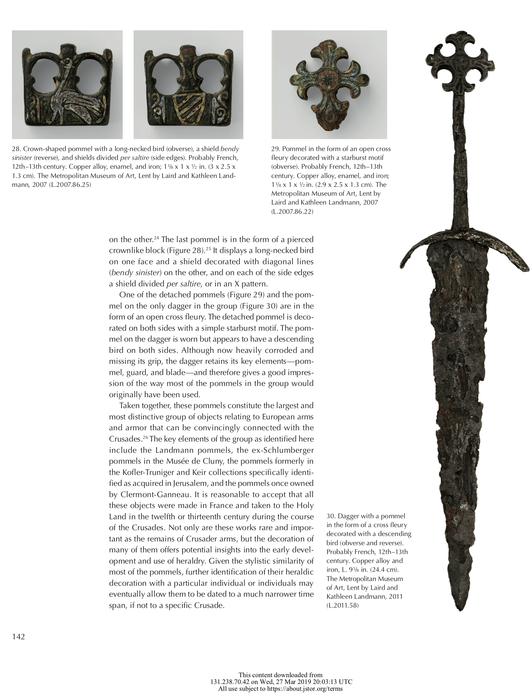
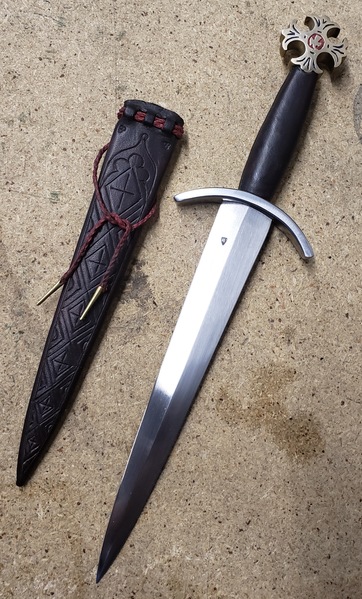
There are at least a half dozen pommels of the form on this dagger pommel. There are also a number of lozenge-shaped pommels and scalloped-edged round pommels, plus a couple with crown shaped pommels and other forms. A description and more pics can be found in this article from the Metropolitan Museum Journal. The article dates many of them to the 12th-13th century and frequently labels them "probably French." All the pommels--a couple dozen from that article--are cast bronze (often hollow) and most were found in and around the Holy Land. They appear to be decorated with enamel, which probably adds to the "probably French" attribution. Another article in the thread linked above shows another set of related bronze pommels found by metal detectorists in the UK.
While it's impossible and illogical to say that 12th-13th century daggers had to have a bronze pommel based on this sample set of data, making a reproduction dagger with a bronze pommel of these forms wouldn't be odd.  Blade forms are more speculative, as we have the Met example as the only complete, documented dagger. The dagger posted by Cornelis Tromp (who collects antiques) in the thread has a pommel of this form, but the guard's shape/coloring/patination give me a little pause. I wonder if it wasn't a later addition to "complete" the piece. I have zero documentation to back that up, though. it's more a gut feeling. Blade forms are more speculative, as we have the Met example as the only complete, documented dagger. The dagger posted by Cornelis Tromp (who collects antiques) in the thread has a pommel of this form, but the guard's shape/coloring/patination give me a little pause. I wonder if it wasn't a later addition to "complete" the piece. I have zero documentation to back that up, though. it's more a gut feeling.

ChadA
http://chadarnow.com/
|
|
    |
 |
Craig Johnson
Industry Professional

|
 Posted: Mon 27 Apr, 2020 5:16 am Post subject: Excellent addition Posted: Mon 27 Apr, 2020 5:16 am Post subject: Excellent addition |
 |
|
Thanks for posting that Chad. That is an excellent addition to this thread and the research. When seeing Josh work on these pieces I was amazed at how small they were. (one of my constant blind spots, period stuff is usually smaller than we assume, constantly have to remind myself to check the actual specs).
One of the interesting aspects of these particular pommels and the dagger is how they are not just basic forms. It illustrates that even at this early date our basic modern western concept of everything has to evolve from simple to comlex or plain to fancy is probably not the truth of the matter.
I should have remembered to add this to the thread a while ago. I fear it gets to busy sometimes :-) But I am always on the look out for more evidence to contribute to this story of the early cross hilted dagger.
Best
Craig
|
|
    |
 |
Chad Arnow
myArmoury Team


|
 Posted: Mon 27 Apr, 2020 5:52 am Post subject: Re: Excellent addition Posted: Mon 27 Apr, 2020 5:52 am Post subject: Re: Excellent addition |
 |
|
| Craig Johnson wrote: | | Thanks for posting that Chad. That is an excellent addition to this thread and the research. When seeing Josh work on these pieces I was amazed at how small they were. (one of my constant blind spots, period stuff is usually smaller than we assume, constantly have to remind myself to check the actual specs). |
The one Josh made for me isn't very large and was sized up from the original. Again, we only have the Met dagger to go on as a complete example with specs, but it's tiny, relatively speaking.

ChadA
http://chadarnow.com/
|
|
    |
 |
Chad Arnow
myArmoury Team


|
|
    |
 |
|
|
You cannot post new topics in this forum
You cannot reply to topics in this forum
You cannot edit your posts in this forum
You cannot delete your posts in this forum
You cannot vote in polls in this forum
You cannot attach files in this forum
You can download files in this forum
|
All contents © Copyright 2003-2025 myArmoury.com — All rights reserved
Discussion forums powered by phpBB © The phpBB Group
Switch to the Basic Low-bandwidth Version of the forum
|

